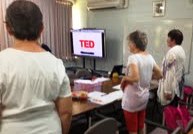Looks like I am doing all the talking, but in fact, it was a chance to meet one another. The centre provided a healthy, and large afternoon tea.
Then the hard work started. We discussed the notion of functional independence and Anne Livingstone explained the context of the project in the wider scheme. Participants received their purple books "Ageing with Vitality" (Qld Health) and a journal, and were set to work immediately
Smart Goals
We looked at SMART goals. These are small steps on our way to a larger ideas. Smart stands for
- Specific
- Measurable
- Achievable
- Readiness
- Time based.
Types of Exercise
There are four types of exercise that older adults need to stay independent, and vital. These are- Endurance also can be called, Cardio Vascular, or aerobic exercise
- Strength,
- Balance
- Flexibility
We walked up and down the hall way a couple of times to warm up.
For a strength exercise, we learned the squat, it is so important to be able to perform a squat. It makes our legs stronger in the muscles that really need strengthening, namely the gluteal, hamstrings and quads. It is so important for daily tasks like, getting up out of a chair, bending safely and lifting a heavy load safely.
You can hold on lightly to the back of a chair or to the table while you perform your squat. Remember,
- bend from the hips first,
- keep your body weight back onto your heels
- keep your head up
- exhale on the way up.
Technology
We cranked up the computer and watched a TED talk(Technology, Education and Design) featuring Laura Carstensen entitled "Older People are Happier" We had a discussion about technology and learning typing. Texting was seen as a means of keeping in touch with the younger generation.Next Week
Balance, smart goals, technology, Assistive Technology.
Some reading for preparation if you like.
Have a look at: www.ilcaustralia.org.au.Read the next section of "Ageing with Vitality" Section 3 and 4.
Meanwhile good luck with your smart goals.








